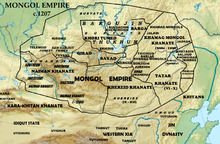Naimans

Location of the Naiman khanate at the start of the Mongol Empire.
|
|
| Regions with significant populations | |
|---|---|
| Languages | |
| Naiman subdialect of Mongolic languages | |
| Religion | |
| Tibetan Buddhism, Shamanism |
The Naiman (Khalkha-Mongolian: Найман/Naiman, "eight") is the name of a tribe originating in Mongolia.
In The Secret History of the Mongols, the Naiman subtribe the "Güchügüd" are mentioned. According to Russian Turkologist Nikolai Aristov's view, the Naiman Khanate's western border reached the Irtysh River and its eastern border reached the Mongolian Tamir River. The Altai Mountains and southern Altai Republic were part of the Naiman Khanate. They had diplomatic relations with the Kara-Khitans, and were subservient to them until 1177. Some scholars classified them as a Turkic people from Sekiz Oghuz (means "Eight Oghuz" in Turkic). Like the Khitans and the Uyghurs, many of them were Nestorian Christians or Buddhists. When the last Dayan Khan was killed after a battle with Genghis Khan in 1203, his son Kuchlug with his remaining Naiman troops fled to the Kara-Khitan Khanate. Kuchlug was well received there and the Khitan Khan gave him his daughter in marriage. Kuchlug soon began plotting against his new father-in-law, and after he usurped the throne, he began to persecute Muslims in the Hami Oases. But his action was opposed by local people and he was later defeated by the Mongols under Jebe.
...
Wikipedia
